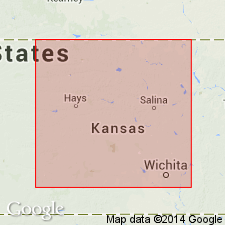
- Usage in publication:
-
- Janssen clay member
- Modifications:
-
- Named
- Dominant lithology:
-
- Clay
- Lignite
- Silt
- Shale
- AAPG geologic province:
-
- Central Kansas uplift
Summary:
Named as upper member (of 2) of Dakota formation; probably named for Janssen Station, Ellsworth Co, KS on the Central Kansas uplift. Type area designated near Janssen Station in center S line sec 3, T16S, R9W, Ellsworth Co. Occurs in Ellsworth, Ford, and Hodgeman Cos, KS. In generalized measured section of the Dakota in north-central KS, Janssen consists largely of gray to dark-gray clay and silt, some beds of fissile shale, and commonly a bed of lignite or highly lignitic clay; ranges in overall thickness here from 0.1 to 83 ft total. Dominant clay mineral is kaolinite. In some areas, forms well-defined bench on the hills. Most characteristic feature is presence of vertical holes or channels, some of which are branched. Overlies Terra Cotta clay member (new) of Dakota formation; underlies Graneros shale. Measured sections. Cross section. Of Cretaceous age.
Source: GNU records (USGS DDS-6; Denver GNULEX).
For more information, please contact Nancy Stamm, Geologic Names Committee Secretary.
Asterisk (*) indicates published by U.S. Geological Survey authors.
"No current usage" (†) implies that a name has been abandoned or has fallen into disuse. Former usage and, if known, replacement name given in parentheses ( ).
Slash (/) indicates name conflicts with nomenclatural guidelines (CSN, 1933; ACSN, 1961, 1970; NACSN, 1983, 2005, 2021). May be explained within brackets ([ ]).

